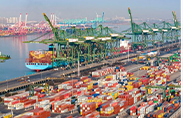Rough waters ahead for Great Lakes shipping as US protectionism tests good neighbours
 The shipping arteries of the Great Lakes, stretching from Montreal to Milwaukee, are feeling the strain of renewed US protectionism and simmering trade tensions with Canada. Once hailed as a symbol of North American industrial cooperation, the Lakes are becoming a battleground where tariffs, red tape and shifting supply chains are redrawing the economic map of the region. The shipping arteries of the Great Lakes, stretching from Montreal to Milwaukee, are feeling the strain of renewed US protectionism and simmering trade tensions with Canada. Once hailed as a symbol of North American industrial cooperation, the Lakes are becoming a battleground where tariffs, red tape and shifting supply chains are redrawing the economic map of the region.
Recent moves by the US, including steel and aluminium tariffs, as well as "Buy American" procurement rules, have unnerved Canadian officials and business leaders alike. Ottawa has responded in kind, threatening countermeasures that could further dampen cross-border flows. For the shipping sector, especially those operating across the St Lawrence Seaway and into the inland ports, the effect has been uneven, exposing vulnerabilities in a system long taken for granted.
Holding firm, but with caveats Montreal, the eastern gateway to the Great Lakes, has managed to weather the storm better than most. As Canada’s second-largest port and its leading container hub for eastern North America, the Port of Montreal has diversified beyond its historical dependency on US-bound cargo. Volumes fell slightly in early 2025, largely due to a dip in transhipment bound for the US Midwest, but increases in European and North African trade have kept overall TEU figures relatively stable.
Nevertheless, concerns are rising over container dwell times and rising insurance costs, as shippers worry about possible US retaliation in the form of further tariffs or inspections. “We’re keeping an eye on all policy announcements out of Washington,” said Martin Imbeault, logistics director at CMA CGM Canada. “Every new measure has a knock-on effect in our supply chains.”
Further inland, Thunder Bay, traditionally a grain export hub for the Canadian Prairies, has seen a sharper downturn. US tariffs on Canadian wheat and barley, framed as anti-dumping measures, have throttled agricultural exports through the Seaway. In response, some grain is being rerouted westward to Vancouver or trucked south to bypass the Great Lakes altogether.
The result is a port operating at under 70 per cent of capacity, with bulk cargo volumes down nearly 18 per cent year on year. “The trade corridor is breaking down,” lamented JR McAllister, president of the Thunder Bay Port Authority. “The whole value proposition of Great Lakes shipping is seamless North American integration. Without that, we’re just a cold-water bottleneck.”
On the US side, Milwaukee has emerged as a relative winner, thanks in part to the shifting patterns in liquid bulk. With Canadian petroleum exports facing more restrictions, US refineries around the Great Lakes have increased shipments to inland distribution hubs like Milwaukee and Toledo. The Port of Milwaukee reported a 12 per cent rise in inbound petroleum products in the first half of 2025, driven by domestic rerouting and stockpiling.
There is a downside, however: greater reliance on domestic liquid bulk traffic leaves the port vulnerable to price fluctuations and environmental scrutiny. Local opposition to tank farm expansions is mounting, and long-term contracts remain elusive. Still, Milwaukee’s gains in liquid bulk have offset losses in packaged freight and containerised goods, which remain sluggish amid trade uncertainty.
Ro-ro and air cargo in flux
Packaged freight, especially ro-ro traffic, has been one of the more sensitive casualties of the transborder friction. The ports of Windsor and Detroit, key nodes for automotive trade, are experiencing delays and volume drops as manufacturers hedge their bets. Canadian parts are now more frequently trucked through Buffalo or flown out of Toronto, bypassing traditional Lake crossings.
Air cargo has picked up some of the slack, particularly on high-value goods. Toronto Pearson and Chicago O’Hare have both seen low double-digit increases in crossborder air freight in 2025. However, this is hardly good news for the ports: air transport is more carbon-intensive and costly, representing a retreat from the efficiency of multimodal lake shipping.
The twin stories of Duluth and Hamilton illustrate the broader divergence. Duluth, a major bulk and project cargo port, has suffered from collapsing demand for iron ore and taconite, exports that once fed steel mills in the Great Lakes region. With tariffs clouding demand and US mills increasingly turning to domestic sources, outbound tonnage has dropped 23 per cent since 2023.
Hamilton, on the other hand, is quietly thriving. Leveraging its proximity to southern Ontario’s manufacturing belt, it has become a hub for regional distribution and warehousing. While bulk steel has declined, containerised freight – especially from Europe and the Middle East – is on the rise. A planned intermodal terminal by CN Rail promises to strengthen Hamilton’s logistics credentials, making it one of the few Canadian ports to attract sustained investment amid the turmoil.
The current tensions have laid bare the fragility of the Great Lakes shipping system, which has long depended on predictable policy and strong bilateral ties. The sector’s complexity – spanning bulk commodities, containerised freight, ro-ro, and liquid cargo – means there are no blanket winners or losers, only ports and players better positioned to adapt.
For now, the fate of Great Lakes shipping hangs on political decisions made far from its waters – in Washington and Ottawa. As both governments play to domestic audiences, the risk is that the very connectivity that made the Lakes a vital artery of North American commerce could be irreparably weakened.
Unless cooler heads prevail and trade barriers are rolled back, what was once a corridor of integration may become a patchwork of isolated ports, each fighting for relevance in an age of rising walls. |